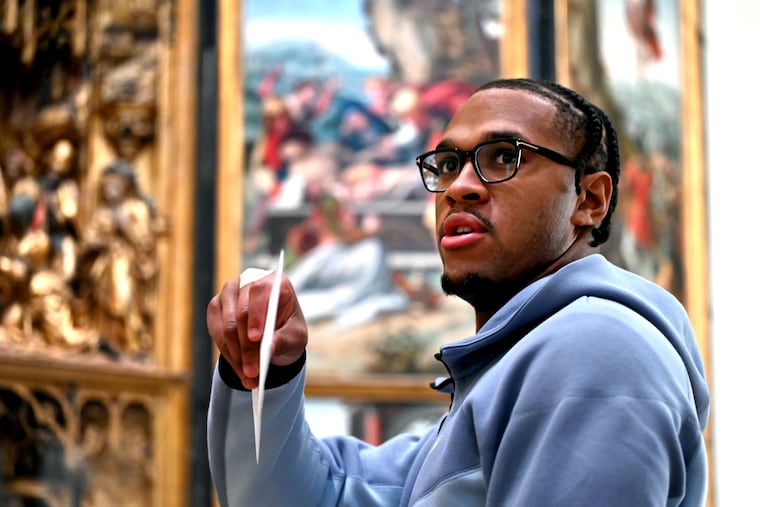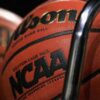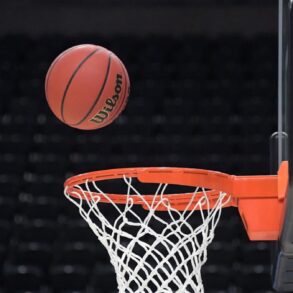
Eric Dixon might wish to one day design an exhibition inside a museum, but he didn’t do well in his art history class at Villanova. In fact, it’s fair to say he didn’t like it.
Dixon, a fifth-year forward at Villanova, has always been into history. It’s what his undergraduate degree is in. He used to pass time on the way to basketball tournaments in the car with his parents by playing various versions of historical trivia. But looking at a painting and identifying what it says about the mood? About the era it was from?
“I don’t necessarily look at the art for the art,” Dixon said.
That was easy to see as Dixon roamed the halls of the Philadelphia Museum of Art on a January morning with museum curator Matthew Affron. Dixon seemed less enthused by the actual artwork and more about the stories being told. Like when Affron showed off the mid-17th century painting titled Feast of the Wine (The Procession of the Ram), which depicts French peasants leading a sheep to its slaughter.
Dixon was more interested in the clothing the peasants were wearing and what they were doing than analyzing the work’s brushstrokes.
Dixon asked Affron, like he has other curators, what goes into creating exhibits, the stories they tell, and what Affron thinks about when he’s putting one together. Dixon, who turns 24 later this month, might be scoring more points than any player in college basketball right now, but he’s slowly preparing for life after hoops. He dreams of playing in the NBA, a dream he tried to realize last summer before returning to school for a fifth season, or, at the very least, having a successful professional career overseas. But what’s next?
Museum curation is a bit of an abstract idea right now, with so much basketball still ahead, Dixon was reminded.
“It’s an abstract idea, but at the same time the older I get, the more I realize there is more to life than just basketball,” he said.
» READ MORE: Why Joe Lunardi says Villanova’s NCAA Tournament chances are a ‘50-50 shot’
‘Doubters fuel things’
Before Dixon decided to return to Villanova, he and his agent, Darrell Comer, met with Villanova leadership. Dixon hoped last season, his fifth year on campus, would be his last as a college basketball player. He declared for the NBA draft but left open the possibility of returning to school. He was a fringe NBA prospect, an undersized power forward at 6-foot-8 whose experience in college was mostly playing center, a position he wouldn’t be playing at the next level.
The feedback wasn’t great, and so, thanks to name, image, and likeness opportunities, Dixon had a chance to return to Villanova and make more money than he would playing in the NBA’s developmental G League.
In that meeting with Villanova, coach Kyle Neptune told Dixon he thought he could be the best player in college basketball this season. He thought it in general, but he really meant if Dixon came back to Villanova. He was going to be the focal point of everything Villanova does, and the staff recruited a point guard, Jhamir Brickus, who could get Dixon the ball and help him score.
Dixon’s entire offseason last year was about transforming himself. He worked on his body and his game while training in Texas and elsewhere. He learned what it was going to be like to be and train like a pro, too.
» READ MORE: Sielski: Dan Hurley says Villanova is NCAA Tournament-bound. The Wildcats still have to prove it.
The biggest change in his training, Dixon said, was his make-based approach. He used to just focus on a raw number of shots, not really how many of them went in. At the Sports Academy in Frisco, Texas, he worked with trainer Irv Roland and would have to hit a specific targeted number of makes from different spots on the court. His days went from making 400 shots instead of shooting 500 shots. Perhaps that’s the reason he is shooting 47.5% from three-point range and leading the nation in scoring at 24.8 points per game.
“That’s what my trainer would tell you,” Dixon said. “I don’t know what it is. This team has helped me. I don’t have to force anything. It sounds crazy. I probably average an insane amount of shots. But I don’t feel like I force anything and I don’t have to.”
Dixon’s teammate, Jordan Longino, said Dixon is “probably the one guy who is in the gym the most on our team.” He works out separately with trainer Seth Brunner. There are few, if any, off days. Dixon is playing himself onto some NBA draft boards, though he still projects as a second-round pick.
Asked if all of this was a big screw-you tour for the NBA executives who had no interest in him, Dixon said no.
“I mean obviously as a competitor doubters fuel things,” Dixon said. “But it’s more for people who believe in me. Coach Nep has had the faith in putting a team pretty much in my hands for the last two seasons. And so can I pay him back for that? My teammates, I saw them work all summer, but do they believe that I’m a gamer? Are they going to believe in me to make shots in big moments?
“And my family. They believed in me when I didn’t believe in myself. I know that they believe in me now. Can I prove them right? Can I make them look good? That’s more so the motivation.”
Dixon pushed back on using the word disappointment to describe being back at Villanova this season and not playing professionally. It’s all about perspective. Sure, he had big dreams as a kid and still does, but he said he was also realistic. He used to think if he played at Division II Millersville like his father, Eric, that he would be set.
» READ MORE: Villanova’s Eric Dixon is waging an All-American campaign, and he’s starting to get some help from his teammates
“To me it was like, ‘OK, you’re really this close,’” Dixon said. “Why would I not work as hard as I can when you’re this close to achieving something that you really didn’t think was possible?”
Chasing history
Dixon has what Neptune calls a “photographic memory.”
The staff prints out scouting reports before every game and Dixon routinely memorizes them and recites them verbatim in his soft, monotone voice.
“His mind is impressive,” Neptune said. “He sees plays. He’ll call things out. Whenever he’s in coverages, he’ll know every player and what they do, their strengths and weaknesses, the plays, he just can pick things up and retain them at a really high level.”
Dixon used to be a fairly soft-spoken player on and off the court. When he arrived on campus, the program had veteran leaders. When it was his turn, it didn’t come that easy to him. He’s the lead-by-example type.
“Sometimes I think that’s even better,” Longino said. “Having a lot of young guys and a lot of transfers, they can see him doing it and they can just follow suit.
“We go as he goes.”
But Dixon has also been much louder this season.
» READ MORE: Villanova’s Kyle Neptune and Eric Dixon embody the pressure and promise of modern college hoops
“I think he’s taken a more formidable role in the huddles on the court just galvanizing the guys and it’s been a key for us,” Neptune said. “I think the best teams are player-led. The best teams have a heartbeat out there on the floor at all times and they’re getting it done together as a unit. No knock against the team last year but I just think that Eric has really embodied that role this year.”
Even if he was a bit reluctant.
“It’s scary to put everything in,” Dixon said. “It’s hard to put everything into something and fail. I’m trying to fight that fear.”
The Wildcats’ season started slow, with four losses in seven games, but they have righted the ship in large part because of Dixon’s scoring prowess. If they finish the turnaround with an NCAA Tournament berth, it will be because of him.
History is in sight, too. Dixon will soon become the ninth player in Villanova history to score 2,000 points. Kerry Kittles’ program record of 2,243 points is doable. If Dixon continues to score 25 points per game, he would pass Kittles during Villanova’s final regular-season game on March 4 at Georgetown. He knows it’s out there.
“It’s not a focus,” he said. “I care more about this team winning and showing to myself that I can be the kind of leader that I want to be more so than breaking that record.
» READ MORE: Is Eric Dixon the last vestige of the Villanova Way? Villanova hopes not.
“Obviously we haven’t won the amount of games that we would like to over the last few years. My goal is really to have respect and relationships and a bond with the guys that I can maintain for decades down the line. I think the younger version of me would look at this version most surprised by that.”
The Time is Always Now
Dixon spent part of his summer in Europe with his girlfriend. During their time in Barcelona, they went to the Moco Museum.
There’s a traditional depiction of the Last Supper on display at the Philadelphia Museum of Art, but the Moco had a more “rebellious” version from photographer David LaChapelle that portrays a group of young men, some of them Black, “who are often stereotyped and even stigmatized by the clothes they wear,” according to the museum. “The work shares the sentiment that the apostles were perhaps a group of misfits, joined together with common beliefs and a sense of brotherhood.”
“I think it’s interesting,” Dixon said. “I enjoyed it. I definitely thought it was more relatable.”
Much more relatable than one room Affron took him into during his tour, with 18th-century furniture, cabinets, tapestries, and more.
“I don’t know if I would have picked those couches,” Dixon said. “They don’t look too comfortable.”
Later, Dixon walked through The Time Is Always Now, a limited-time exhibit that features “Black and African diasporic contemporary artists who use figurative painting, drawing and sculpture to illuminate and celebrate the nuance and richness of Black contemporary life.”
If Dixon later becomes a museum curator, it will more mimic something like this rather than a room with old paintings or furniture.
“This is a museum which is full of these great stories of all cultures,” Affron said at one point during the tour.
Dixon’s story, meanwhile, is still unfolding. What comes next is still unknown. Museum curation isn’t what he considers a dream job, but it’s one that he thinks he could “just sit back and enjoy it” one day after he’s made money playing basketball.
The idea that there’s more to life than hoops? Dixon said he learned that lesson as a freshman, where he was a highly ranked recruit forced to redshirt because there were no minutes for him on Jay Wright’s juggernaut. Dixon’s journey from that redshirt season as a self-described chubby kid to college star is part of who he is. He’s the last of his kind in a way in the modern state of college basketball, but those early seasons formed this version of him in every way.
He used to call home and tell his parents that he’d never play basketball at this level. He had been a star in high school, scoring more than 2,000 points at Abington High, but he wasn’t playing. He lost his identity but gained perspective.
“Just taking time to understand myself as a person, understand that I’m a son, a brother, a friend first, and having that deeper understanding of myself came from that year and losing the game in a way,” Dixon said. “I was blessed to not be injured or anything like that, but you lose the game. You lose those crucial 40 minutes of your life that you work so hard for.”
Neptune, who helped recruit Dixon to Villanova as one of Wright’s assistants, said he saw Dixon “merging his mind and his game” during those early years.
“Those habits that he created were the foundation for what he is now,” Neptune said.
And who he may become.
This post was originally published on this site be sure to check out more of their content.






